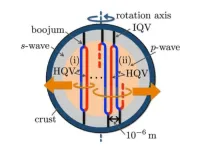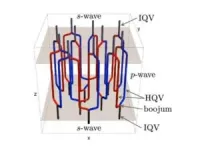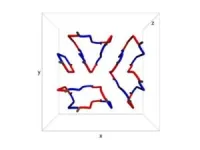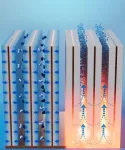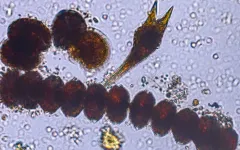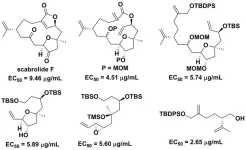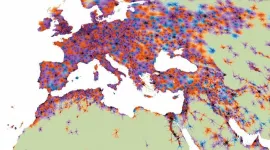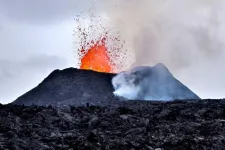(Press-News.org) Stars blinking code in Netflix’s “3 Body Problem” might be science fiction, but by deciphering neutron stars’ erratic flickers, a new study has revealed the twisted origin of these dead stars’ mysterious “heartbeats.”
When neutron stars—ultra-dense remnants of massive stars that exploded in supernovae—were first discovered in 1967, astronomers thought their strange periodic pulses could be signals from an alien civilization. Although we now know these “heartbeats” originate from radiation beams of stellar corpses, not extraterrestrial life, their precision makes them excellent cosmic clocks for studying astrophysical phenomena, such as the rotation speeds and internal dynamics of celestial bodies.
At times, however, their clockwork accuracy is disrupted by pulses inexplicably arriving earlier, signaling a glitch or a sudden speed-up in the neutron stars’ spins. While their exact causes remain unclear, glitch energies have been observed to follow the power law (also known as scaling law)—a mathematical relationship reflected in many complex systems from wealth inequality to frequency-magnitude patterns in earthquakes. Just as smaller earthquakes occur more frequently than larger ones, low-energy glitches are more common than high-energy ones in neutron stars.
Re-analyzing 533 up-to-date data sets from observations of rapidly spinning neutron stars, called pulsars, a team of physicists found that their proposed quantum vortex network naturally aligns with calculations on the power law behavior of glitch energies without needing extra tuning, unlike past models. Their findings are published in the journal Scientific Reports.
“More than half a century has passed since the discovery of neutron stars, but the mechanism of why glitches happen is not yet understood. So we proposed a model to explain this phenomenon,” said study corresponding author Muneto Nitta, a specially appointed professor and co-principal investigator at Hiroshima University’s International Institute for Sustainability with Knotted Chiral Meta Matter (WPI-SKCM2).
Superfluid vortices get a new twist
Previous studies have proposed two main theories to explain these glitches: starquakes and superfluid vortex avalanches. While starquakes, which behave like earthquakes, might explain the observed power law pattern, they could not account for all types of glitches. Superfluid vortices are the widely invoked explanation.
“In the standard scenario, researchers consider that avalanche of unpinned vortices could explain the origin of glitches,” Nitta said.
However, there has been no consensus on what might trigger vortices to avalanche catastrophically.
“If there would be no pinning, it means the superfluid releases vortices one by one, allowing for a smooth adjustment in rotation speed. There would be no avalanches and no glitches,” Nitta said.
“But in our case, we didn't need any mechanism of pinning or additional parameters. We only needed to consider the structure of p-wave and s-wave superfluids. In this structure, all vortices are connected to each other in each cluster, so they cannot be released one by one. Instead, the neutron star has to release a large number of vortices simultaneously. That is the key point of our model.”
While a neutron star’s superfluid core spins at a constant pace, its ordinary component lowers its rotation speed by releasing gravitational waves and electromagnetic pulses. Over time, their speed discrepancy grows so the star expels superfluid vortices, which carry a fraction of angular momentum, to regain balance. However, as superfluid vortices are entangled they drag others with them, explaining the glitches.
To explain how vortices form twisted clusters, researchers proposed the existence of two types of superfluids in neutron stars. S-wave superfluidity, which dominates the outer core’s relatively tamer environment, supports the formation of integer-quantized vortices (IQVs). In contrast, p-wave superfluidity prevailing in the inner core’s extreme conditions favors half-quantized vortices (HQVs). As a result, each IQV in the s-wave outer core splits into two HQVs upon entering the p-wave inner core, forming a cactus-like superfluid structure known as a boojum. As more HQVs split from IQVs and connect through boojums, the dynamics of vortex clusters become increasingly complex, much like cacti arms sprouting and intertwining with neighboring branches, creating intricate patterns.
The researchers ran simulations and found that the exponent for the power-law behavior of glitch energies in their model (0.8±0.2) closely matched the observed data (0.88±0.03). This indicates that their proposed framework accurately reflects real-world neutron star glitches.
“Our argument, while simple, is very powerful. Even though we cannot directly observe the p-wave superfluid inside, the logical consequence of its existence is the power-law behavior of the cluster sizes obtained from simulations. Translating this into a corresponding power-law distribution for glitch energies showed it matches the observations,” said co-author Shigehiro Yasui, a postdoctoral researcher at WPI-SKCM2 and associate professor at Nishogakusha University.
“A neutron star is a very particular situation because the three fields of astrophysics, nuclear physics, and condensed matter physics meet at one point. It’s very difficult to observe directly because neutron stars exist far away from us, therefore, we need to make a deep connection between the interior structure and some observation data from the neutron star.”
Yasui and Nitta are also affiliated with Keio University’s Department of Physics and Research and Education Center for Natural Sciences. Another collaborator in the study is Giacomo Marmorini from the Department of Physics of both Nihon University and Aoyama Gakuin University.
###
About the World Premier International Research Center Initiative (WPI)
The WPI program was launched in 2007 by Japan’s Ministry of Education, Culture, Sports, Science and Technology (MEXT) to foster globally visible research centers boasting the highest standards and outstanding research environments. Numbering more than a dozen and operating at institutions throughout the country, these centers are given a high degree of autonomy, allowing them to engage in innovative modes of management and research. The program is administered by the Japan Society for the Promotion of Science (JSPS).
See the latest research news from the centers at the WPI News Portal: https://www.eurekalert.org/newsportal/WPI
Main WPI program site: www.jsps.go.jp/english/e-toplevel
About the International Institute for Sustainability with Knotted Chiral Meta Matter (WPI-SKCM²) Hiroshima University
While introducing a new research paradigm of “knotted chiral meta matter,” WPI-SKCM² aspires to create artificial materials by design to help address challenging global problems, like the growing energy demand and climate change. By knotting and knitting physical fields and molecules, much like in the Japanese art form of Mizuhiki, we enable new physical behavior and desirable properties that overcome nature’s limitations, such as enabling thermal superinsulation that could save energy for heating and cooling buildings. Recreating natural phenomena in experimentally accessible systems leads to insights into the fundamental laws of nature at scales from its smallest building blocks to the entire Universe. Learn more: https://wpi-skcm2.hiroshima-u.ac.jp/
END
Study reveals twisted origin of dead stars’ mysterious ‘heartbeats’
2024-06-26
ELSE PRESS RELEASES FROM THIS DATE:
Some landfill ‘burps’ contain airborne PFAS, study finds
2024-06-26
Many municipal landfills “burp” gas from decomposing organic matter rather than letting it build up. And burps from buried waste containing per- and polyfluoroalkyl substances (PFAS) can release these “forever chemicals” into the air, say researchers in ACS’ Environmental Science & Technology Letters. Their study reports unexpectedly high levels of airborne PFAS at three landfills and demonstrates that vented gases and liquid by-products called leachates could transport similar amounts of these contaminants to the environment.
Some consumer products and commercial waste, such as children’s clothing, cosmetics and wastewater treatment sludge solids, contain ...
Small, adsorbent ‘fins’ collect humidity rather than swim through water
2024-06-26
Clean, safe water is a limited resource and access to it depends on local bodies of water. But even dry regions have some water vapor in the air. To harvest small amounts of humidity, researchers in ACS Energy Letters have developed a compact device with absorbent-coated fins that first trap moisture and then generate potable water when heated. They say the prototype could help meet growing demands for water, especially in arid locations.
Earth’s atmosphere holds trillions of liters of fresh water as vapor, but it’s challenging to collect this colorless, transparent and dilute gas. Previously, researchers developed systems that trap ...
Plankton researchers urge their colleagues to mix it up
2024-06-26
Comprising the base of the food web, plankton are extremely important to marine ecosystems. However, there is still much to be discovered about these organisms, and that’s especially true for mixoplankton.
Plankton are typically divided into two groups. Similar to plants, phytoplankton contain chlorophyll and derive energy from photosynthesis. Zooplankton, on the other hand, consume other organisms for their energy. However, there is also a third group, mixoplankton, that is a combination of the two. And, despite accounting for, at times, more than half of all plankton in the ocean, they remain ...
Leading-edge model predicts impact of river plants on flood level
2024-06-26
River plants provide ecological and environmental benefits, but they raise flood risk by blocking the flow during heavy rain. Removing woody riparian vegetation patches is a primary flood prevention method, but it threatens stream's biodiversity. The research team at the Korea Institute of Civil Engineering and Building Technology (KICT, President Kim, Byung-Suk) has developed a technology for quantifying the effect of river vegetation patches on flood level changes to aid in better decision-making of river management for balancing ecological benefits and flood mitigation.
Rivers ...
Towards non-toxic antifouling agents: A novel method for total synthesis of scabrolide F
2024-06-26
Marine organisms produce many organic compounds with diverse chemical structures and biological activities. These natural marine products are regarded as potential starting points for the discovery and development of new drugs. Among these are norcembranolide diterpenes isolated from the soft corals of the genus Sinularia. These compounds exhibit diverse biological activities, and many of them have anti-cancer and anti-inflammatory properties. Consequently, many studies have investigated the properties of norcembranolide diterpenes and their synthesis methods. Given their potential in drug discovery, developing a synthetic ...
Researchers identify vascular changes in the brain linked to Alzheimer's disease
2024-06-26
JACKSONVILLE, Florida — The blood-brain barrier — a network of blood vessels and tissues that nurtures and protects the brain from harmful substances circulating in the blood — is disrupted in Alzheimer's disease. Now, researchers at Mayo Clinic and collaborators have uncovered unique molecular signatures of blood-brain barrier dysfunction that could point to new ways to diagnose and treat the disease. Their findings are published in Nature Communications.
"These signatures have high potential to become novel biomarkers that capture brain changes in Alzheimer's ...
New global study unveils city-region networks, highlights role of intermediate cities
2024-06-26
Rome - Rural livelihoods are quite intertwined with urban centers, with mid-sized cities playing an extraordinary role in providing required services, including for food security, agricultural livelihoods and viable rural development, according to a new study by researchers at the Food and Agriculture Organization of the United Nations (FAO) and other institutions.
Some two-thirds of the world’s population, or more than 5 billion people, live within one hour of travel time – using locally available means of ...
Scientists discover high-risk form of endometrial cancer — and how to test for it — using AI
2024-06-26
A discovery by researchers at the University of British Columbia promises to improve care for patients with endometrial cancer, the most common gynecologic malignancy.
Using artificial intelligence (AI) to spot patterns across thousands of cancer cell images, the researchers have pinpointed a distinct subset of endometrial cancer that puts patients at much greater risk of recurrence and death, but would otherwise go unrecognized by traditional pathology and molecular diagnostics.
The findings, published today in Nature Communications, will help doctors identify patients with high-risk disease ...
COSPAR welcomes launch of International Space Innovation Centre, Nicosia, Cyprus
2024-06-26
The COSPAR Panel on Innovative Solutions (PoIS) charter aims to bring state-of-the-art technology to address the hardest problems facing COSPAR researchers. PoIS first focused on predicting adverse events from solar activity and applying innovative technologies and sophisticated tools to atmospheric modelling of Mars, Earth, and Venus. This effort led to the creation of the Cyprus Space Research and Innovation Center (C-SpaRC), co-funded by the European Union (EU) in December 2023 as a new infrastructure with related research, with the cooperation of COSPAR. C-SpaRC is now under the auspices of COSPAR, and is designated the COSPAR International ...
Potential long-term volcanic activity on Iceland's Reykjanes Peninsula
2024-06-26
Given the volcanic activity on Iceland over the last three years, researchers from six universities anticipate recurring, moderately sized eruptions of similar style in the coming years to decades. They therefore stress the need for preparedness in view of the risks posed to local populations and critical infrastructure. Their study was recently published in the scientific journal Terra Nova.
“The study uses information from local earthquakes and geochemical data on the erupted magma through time to reveal the geological processes behind these recent Icelandic eruptions. A comparison of these eruptions with historical events provides strong evidence that Iceland will ...
